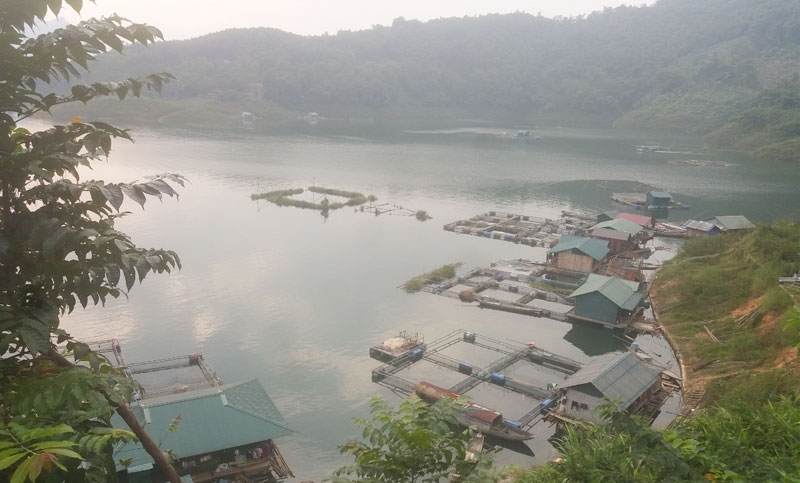
(HBO) - The construction of the Hoa Binh hydropower plant began in 1979. Hundreds of families surrounding the reservoir, including those of Thai Thinh commune, now Hoa Binh commune of the city of the same name, had to leave their residential land for the work.
More than 40 years later, with practical
support policies, lives of those residents went through various changes.
 Caged
fish farming and tourism development are among the orientations for economic
growth of villages around Hoa Binh reservoir in Hoa Binh city.
Caged
fish farming and tourism development are among the orientations for economic
growth of villages around Hoa Binh reservoir in Hoa Binh city.
To stabilise people’s lives, provincial People’s
Committee rolled out a number of support programmes and projects in the
locality. Over the recent past, the committee has approved a project linking the
production with consumption of caged farming fish on Hoa Binh reservoir.
Accordingly, firms will work with locals to
organise a production chain in tandem with consumption of fishery products under
VietGAP standards within three years. As many as 100 cages will be produced, which
is projected to raise over 518 tonnes of fish, raking in more than 20 billion
VND (865,000 USD).
Additionally, Party organisations and
authorities of Hoa Binh commune and Thai Binh ward viewed tourism around the
reservoir a strength in terms of economic development. In many villages,
households make use of natural landscapes comprising of forests, the reservoir
and cultural identity to develop community-based tourism.
Bich Tru village is home to 43 families with
stilt houses. Located on a favourable location with a view of the reservoir and
clean atmosphere, local families are working to turn their houses into an
attractive tourist destination.
As a result of the support policies, including
on-going road building projects, people’s lives witnessed various changes. Of
them, roads leading to Thau and Voi villages (Thai Binh ward) were opened to
traffic years ago, while that linking Bich Tru village with Vay Nua (Da Bac
district) is under construction and expected to complete soon, offering chances
to bolster trade, production, regional linkage and improve people’s lives./.
The Department of Education and Training of Hoa Binh province held a conference on March 18 to review the performance of the "Safe and Happy School" Project and set out tasks for 2025. The project, funded by the Taiwan Fund for Children and Families (TFCF), aims to create a safe, inclusive, and supportive learning environment for students. The event saw the attendance of representatives from the TFCF and 26 beneficiary schools.
With over 70% of their workers being women, trade unions across industrial parks (IPs) in Hoa Binh have been actively safeguarding their legal rights and interests while implementing initiatives to improve their income and well-being.
In recent years, the Hoa Binh provincial General Hospital has continuously innovated itself and improved the quality of medical services to meet the increasing needs of local people. With substantial investments in infrastructure and modern equipment, along with a team of highly qualified doctors and nurses, the hospital has gradually established itself as one of the leading medical units in the Northwestern region and a trusted destination for healthcare for people inside and outside the province.
From mastering the fundamentals of programming to achieving national recognition, the Programming Club of the Le Van Tam Primary School (STAR LVT28) in Hoa Binh city has made remarkable strides in the field of robotics.
The Ho Chi Minh Communist Youth Union Committee and the Vietnam Youth Federation chapter of Hoa Binh province organised a programme on March 12 to launch the "Digital Literacy" movement and an online quiz on the resolutions of the Vietnam Youth Federation congresses at all levels, as well as the Politburo's Resolution No. 57-NQ/TW on breakthroughs in the development of science, technology, innovation, and national digital transformation.
As climate change grows more unpredictable, the development of production forests has become essential - not just for economic growth, but for safeguarding the environment and maintaining ecosystem balance. By boosting local incomes, curbing natural disasters, preventing soil erosion, and protecting water resources, these forests play a crucial role in sustainable development.



 Caged
fish farming and tourism development are among the orientations for economic
growth of villages around Hoa Binh reservoir in Hoa Binh city.
Caged
fish farming and tourism development are among the orientations for economic
growth of villages around Hoa Binh reservoir in Hoa Binh city.